The Law of Material Sufficiency
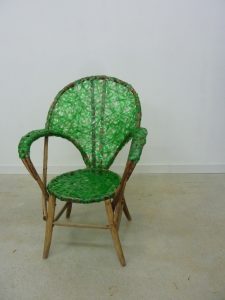 Over the years I have noticed a little known phenomenon and as I have never seen a name given to it I have decided to call it the Law of Material Sufficiency. Not dissimilar to Parkinsons Law (Cyril Northcote Parkinson 1955) “work expands to fill the time available for its completion” …….. it works like this….
Over the years I have noticed a little known phenomenon and as I have never seen a name given to it I have decided to call it the Law of Material Sufficiency. Not dissimilar to Parkinsons Law (Cyril Northcote Parkinson 1955) “work expands to fill the time available for its completion” …….. it works like this….
Having done some experiments and decided that I want to use a particular material for whatever it is that I am making, I then select from my boxes and sacks of collected materials the actual materials for the task. As I don’t buy materials there needs to be enough for whatever job I have planned for it but, this is very difficult to guage accurately so, usually, I just hope and trust that there will be enough. The astonishing thing is, that nearly every time it works to such a fine degree that I find myself scrabbling in the bottom of a sack or a box to root out the last few centimetres of whatever it is to add the final touches, and it happened again this week.
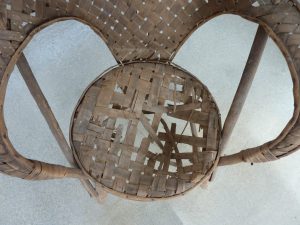
I was given a Limousin woven chestnut chair in very poor condition. Filthy, riddled with woodworm, a lot of broken splints and the joints very loose and after giving it a serious scrubbing I realised that actually I didn’t like the chestnut splints very much. But I found the curved form and simple stick structure of the chair very seductive so I decided to use the broken splints as fire lighters, but keep the frame and restore it in my own way.
My initial idea was to use either tetra paks or corrugated cardboard in the same fashion as the splints, that is, to weave panels and then nail the completed panels to the back and seat. But weaving a panel and attaching it to something never excites me as much as working 3 dimensionally and as I was restoring the chair for my own use I saw no reason why I should bore myself whilst doing it. In addition I find it hard to trust nails now after too many experiences of splitting wood by using the wrong nail for the job, and the chair was already splatter-gunned with nail holes. So, I abandoned the panel idea. Weaving over the structure with tetra pak and cardboard strips was the next thing I tried, but neither felt strong enough and the curved shape didn’t lend itself to this type of weave.
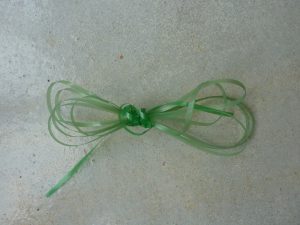 There is a sack of used polypropylene strapping tape in my studio. It is the remains of a large amount of waste tape that I collected some years ago from a packaging company in London for a public commission that I was working on at the time .The tape came wrapped around the pallets of cardboard they imported and every day of the week they threw out one or two skips full of it. The skips were emptied into a barge on the Thames that floated downstream to the implausible sounding Mucking landfill site in Essex where this still perfectly functional tape was interred along with all the rest of Londons’ so called waste. Something that struck me when I collected the material from the company was that the workers there obviously sensed that the material was not really ‘waste’ because they often bundled it into neat little hanks before throwing it into the skip, even though they were not asked to do this.
There is a sack of used polypropylene strapping tape in my studio. It is the remains of a large amount of waste tape that I collected some years ago from a packaging company in London for a public commission that I was working on at the time .The tape came wrapped around the pallets of cardboard they imported and every day of the week they threw out one or two skips full of it. The skips were emptied into a barge on the Thames that floated downstream to the implausible sounding Mucking landfill site in Essex where this still perfectly functional tape was interred along with all the rest of Londons’ so called waste. Something that struck me when I collected the material from the company was that the workers there obviously sensed that the material was not really ‘waste’ because they often bundled it into neat little hanks before throwing it into the skip, even though they were not asked to do this.
I have now used most of the colours that I like and had been left with a large amount of very stiff, transclucent green tape that, until now, I have had very little use for as I did not find it particularly attractive or easy to work with. But after a cursory rummage in the sack I realised that its moment had arrived (is this another law – when the right job comes along the material ceases to be unattractive?) and the chair has been woven with it and, as usual, I have been left with barely a metre of tape!
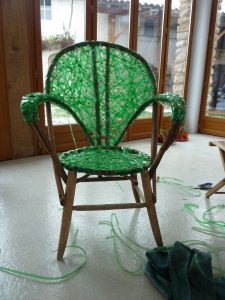
Lois mentioned this the phenomena again when working on a collaborations between potters and basket makers eith Nathalie Du Bernard of Poterie des Chals
“When I had finished this piece the sack of green wire was empty, I had needed no more, or no less.”
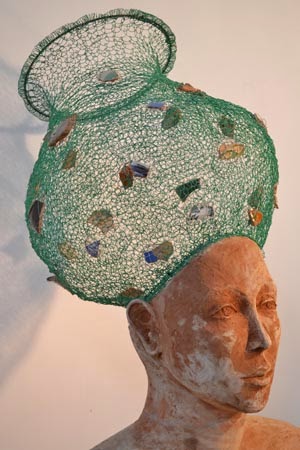
Lois Walpole, Britain

PROFILE
Lois Walpole is of Anglo Scottish heritage and trained in Sculpture, Basket Making and Design.
She works full time as an artist/basket maker taking part in and curating national and international exhibitions, working to commission, designing for production, teaching and writing.
She divides her time between the Shetland Islands and the Charente, in south west France, where her studio is based.
Her blog gives the latest about her teaching and exhibitions and is where she talks about the baskets and basket related things that she finds interesting, inspiring, infuriating and intriguing…
Her self imposed rules are “no materials purchased and basket making techniques employed wherever possible”.
